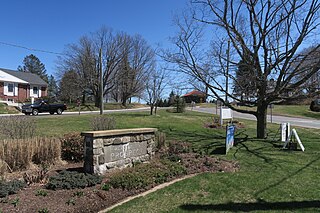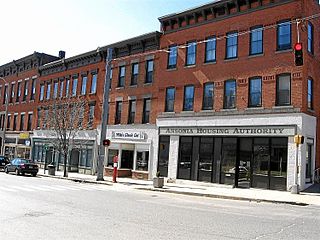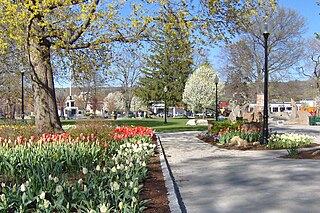
Beacon Falls is a town in western New Haven County, Connecticut, United States. The town is part of the Naugatuck Valley Planning Region & is around 6 miles from Waterbury. It lies in the southwestern part of the state, and is bisected by the Naugatuck River. The population was 6,000 at the 2020 census, down from 6,049 at the 2010 census.

Prospect is a town in the Naugatuck Valley Planning Region, Connecticut, United States. It is a suburb of the nearby city of Waterbury to its north, and is on the north-eastern fringes of the New York metropolitan area. The population was estimated to be 9,401 in 2020. Prospect is part of the Waterbury NECTA and of the historical New Haven County. Prospect is also a member of the regional health district Chesprocott, along with Cheshire and Wolcott.

Ansonia is a city in New Haven County, Connecticut, United States. Located on the Naugatuck River, it is immediately north of Derby, and about 12 miles (19 km) northwest of New Haven. The city is part of the Naugatuck Valley Planning Region. The population was 18,918 at the time of the 2020 census. The ZIP code for Ansonia is 06401. The city is served by the Metro-North Railroad. Ansonia Station is a stop on the railroad passenger commuter service's Waterbury Branch connecting to New York's Grand Central Terminal. Ansonia also is served by the Connecticut Transit bus carrier. Connecticut Route 8 serves Ansonia.

Torrington is the most populated municipality and largest city in Litchfield County, Connecticut, United States, and the Northwest Hills Planning Region. It is also the core city of Greater Torrington, one of the largest micropolitan areas in the United States. The city population was 35,515 according to the 2020 census. The city is located roughly 23 miles (37 km) west of Hartford, 34 miles (55 km) southwest of Springfield, Massachusetts, 67 miles (108 km) southeast of Albany, New York, 84 miles (135 km) northeast of New York City, and 127 miles (204 km) west of Boston, Massachusetts.

Naugatuck is a consolidated borough and town in New Haven County, Connecticut, United States. The town, part of the Naugatuck Valley Planning Region, had a population of 31,519 as of the 2020 Census.

Waterbury is a city in the U.S. state of Connecticut. Waterbury had a population of 114,403 as of the 2020 Census. The city is 33 miles (53 km) southwest of Hartford and 77 miles (124 km) northeast of New York City. Waterbury is the largest city in the Naugatuck Valley Planning Region and second-largest city in New Haven County.
The Naugatuck River Valley is the watershed area of the Naugatuck River in the western part of Connecticut. The Naugatuck Valley straddles parts of Litchfield County, New Haven, and Fairfield counties. The Route 8 corridor and Waterbury Branch of the Metro-North railroad line run along the river valley. Geographically, it comprises the municipalities located within the Naugatuck River basin. During the 19th and 20th centuries, the area was one of the main manufacturing centers in New England, and most of the communities around the river were emblematic New England mill towns.
The Ansonia Clock Company was a clock manufacturing business founded in Ansonia, Connecticut, in 1851 and which moved to Brooklyn, New York, in 1878. The company has produced hundreds of different clock models, including Gingerbread, Porcelain, and Crystal Regulator styles. The business shut down in 2006.

Anson Green Phelps was an American entrepreneur and business man from Connecticut. Beginning with a saddlery business, he founded Phelps, Dodge & Co. in 1833 as an export-import business with his sons-in-law as partners, William E. Dodge in NYC and Daniel James based in Liverpool, England. His third son-in-law, James Boulter Stokes, became a partner some years later.

The Naugatuck River is a 40.2-mile-long (64.7 km) river in the U.S. state of Connecticut. Its waters carve out the Naugatuck River Valley in the western reaches of the state, flowing generally due south and eventually emptying into the Housatonic River at Derby, Connecticut and thence 11 miles (18 km) to Long Island Sound. The Plume and Atwood Dam in Thomaston, completed in 1960 following the Great Flood of 1955, creates a reservoir on the river and is the last barrier to salmon and trout migrating up from the sea.
The Naugatuck Valley League is a 15-team athletic conference of high schools, located in the Naugatuck River Valley of Connecticut.

The Timexpo Museum in Waterbury, Connecticut was dedicated to the history of Timex Group and its predecessors, featuring exhibits dating to the founding of Waterbury Clock Company in 1854. The museum was located in the Brass Mill Commons shopping center with its location marked by a 40-foot (12 m) high replica of an Easter Island Moai statue which connected with the museum's archaeology exhibit. The museum covered 14,000 square feet (1,300 m2) with 8,000 square feet (740 m2) dedicated to the two main exhibits: the company's history of timepieces and archaeology.
The Lower Naugatuck Valley, also known locally as simply "The Valley", is a geographic area located around the confluence of the southern parts of the Housatonic and Naugatuck Rivers. It consists of the municipalities of Seymour, Derby, Ansonia, and outside the Naugatuck watershed, Shelton, which constitute the Valley Council of Governments. The scope of the Lower Naugatuck Valley is also sometimes extended to encompass the next three towns upstream and to the north, which are Beacon Falls, Naugatuck, and Oxford, Connecticut.

The Central Naugatuck Valley is a region of Connecticut in New Haven and Litchfield counties located approximately 70 miles (110 km) northeast of New York City and 110 miles (180 km) southwest of Boston, United States. The region comprises 13 towns: Beacon Falls, Bethlehem, Cheshire, Middlebury, Naugatuck, Oxford, Prospect, Southbury, Thomaston, Waterbury, Watertown, Wolcott, and Woodbury.
Chase Brass is a leading manufacturer of brass rod, ingot and engineered products in the U.S. Located in Montpelier, Ohio, Chase employs over 200 hourly employees who are represented by the United Steelworkers Union (USW) Local 7248, and 98 salaried employees.

Wilfred Elizur Griggs (1866–1918) was an American architect from Waterbury, Connecticut.

The Mad River is a river that flows through northern New Haven County, Connecticut, in the United States.

Robert W. Hill was an American architect from Waterbury, Connecticut. He was one of Connecticut's most important 19th century architects.

The Waterbury Brass Company was an industrial company located in Waterbury, Connecticut. Founded in 1846 by Israel Holmes, it was at its founding the largest maker of rolled brass in the country. The company was folded into the American Brass Company in 1899. Archaeological remains of its manufacturing facility, located in Waterbury's Hamilton Park, were investigated in 1975 and were listed on the National Register of Historic Places.















